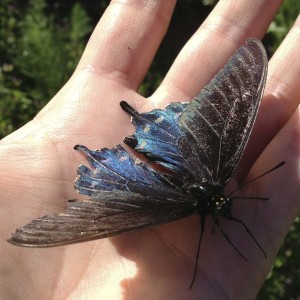Dill is a beautiful, airy plant that grows in an upright fashion. It’s easy to grow and the green foliage has a bit of a blue cast to it, adding an interesting texture, besides. Everyone knows it’s great for cooking and preserving, but it also attracts many beneficial insects, helping with pollination and controlling insect pests. Dill’s small, flat-opening flowers, like fennel and parsley, are favored by small insects like hoverflies and parasitic wasps. Grow them right in your vegetable bed since they love rich soil and help out the veggies!
Botanical Information
Taxonomy
- Latin name: Anethum graveolens
- Family: Umbelliferae (parsley or carrot family)
- dill is also known as Anethum graveolus, Fructus Anethi
History
- Dill is native to Southwest Asia (TKG)
- Countless British children received their first taste of dill from gripe water (TVE)
Physical Description
- grows upright in tall stocks of very slender, feathery leaves
- dill grows 3-4 feet tall, 24″ wide
- very long, hollow taproot
- Dill reseeds itself readily in moist soil
- dill seeds are brown, small and flat-ish
- dill is very similar to fennel in both taste and appearance, but they are different plant (GV)
- The Eastern Black Swallowtail lays its eggs on dill and the caterpillar uses the leaves as its primary food source (REOG)
Varieties & Cultivars
Categories or Types of [plantname]
Colors Available
Varieties (link to ../category/cultivars/tag/[plantname])
Growth Requirements
Climate & Temperature Requirements
Air Temperature
- half-hardy annual warm-season herb (perennial if winters are very mild)
- very sensitive to light freezes and frost (A-Z)
- loves hot weather (A-Z)
Soil Temperature
- for germination: 50-70°F (A-Z)
Humidity
Day Length or Light Requirements
Site Conditions Favored
- full sun
- sheltered from wind
Soil Requirements
Soil Texture
pH
- 5.5-6.5 (A-Z)
- 5.0-8.0 (OGHB)
Nutrient Requirements
- light feeder; might need one application of compost or slow-release fertilizer (A-Z)
- likes moist, rich soil (TKG)
Propagation
Methods of propagation
Seed
- 1/4-1/2″ deep
- best to direct sow, since it doesn’t like transplanting (GV) and dislikes disturbances (TVE)
- starting in mid-spring, or 21-30 days before your last frost date, sow seeds every 2-3 weeks until midsummer for a continuous supply of leaves, (A-Z, GV)
- germination takes 10-14 days
- thin to 6″ apart (GV)
- thin to 12″ apart (TVE)
Division
- not possible
Cuttings
- not possible
Transplanting or Potting Up
- transplant before it’s done with the seedling stage, because it does not transplant well, due to its long taproot (A-Z)
- ready to transplant at about 21-30 days after germination, 14 days after last frost date (A-Z)
Seed Saving
- very easy plant to save the seeds from
- for instructions on harvesting seeds, see Harvesting Methods below
- do not let fennel flower if you are trying to save dill seeds for planting – they will cross-pollinate
Planting Out
Bed Prep & Soil Amendments
Bed Spacing
- For leaf production:
- 6″ apart (GV)
- 8-10″ apart (A-Z)
- For seed production:
- 6″ apart (GV)
- 10-12″ apart (A-Z)
Row Spacing
- 18-24″ between rows (A-Z)
Planting Depth
Alternative Bed Methods
Container Gardening
- Dill can only be grown in a large, deep container, at least 6-8″ in diameter, because of its long taproot (A-Z)
- use very rich soil
- Dill grows well in 1- to 2- gallon containers (TKG)
Routine Cultivation & Maintenance
Water Requirements
- average (A-Z)
- water dill regularly, particularly in hot weather, to keep it from bolting; never let it dry out (GV)
Fertilization Recommendations
- light feeder; might need one application of compost or slow-release fertilizer; side-dressing not necessary (A-Z)
Mulching & Weeding
Pinching or Pruning & Dividing
Support
- Dill requires staking if not grown in a sheltered spot (A-Z)
Winterizing
- Dill won’t survive light freezed or frost, so harvest all that’s available before it gets cold out
Companion Planting
Helpful Companions
- all brassicas (some reports of repelling aphids, spider mites, and caterpillars)
- fruit trees (some reports of dill attracting beneficial wasps, bees, and flies that pollinate blossoms and attack codling moths and tent caterpillars)
Harmful Companions
- Carrot
- Fennel (cross-pollination with dill will lead to odd hybrids next year)
- Tomato (dill attracts tomato hornworms, so dill can be used as a trap crop) (OGHB, A-Z)
Companion to..
Dill is a great companion plant in general, since it contains a chemical repellent or insecticide in its essential oil. (A-Z)
Anecdotal evidence suggests (A-Z) that if planted nearby, dill deters some pests for the following plants:
- Brassica family (cabbage looper, imported cabbageworm)
- Cabbage (Spider mite, caterpillars)
- Fruit trees (codling moth, tent caterpillar)
- Tomatoes (use dill as a trap crop for tomato hornworm)
Pests, Diseases & Problems
Common Pests & Problems
- link to Pest & problems for Dill
- Bolting: water regularly to prevent bolting in hot weather, and pick leaves regularly (GV)
- rarely troubled by pests or diseases (OGHB)
Symptoms
Whole Plant
Leaves
- leaves dwarfed and deformed and abnormally colored
- dill may be infected with a virus: destroy infected plants and control leafhoppers, which spread viruses (OGHB)
- dark spots with yellow edges on dill leaves
- leaf blight: spray plants with fish emulsion, or in severe cases, with sulfur (OGHB)
Stem/Trunk
Flowers
Fruit
Roots
Harvesting & Storage
Edible Parts of the Plant
- leaves (also known as dill weed)
- leaves have a mild aniseed flavor (GV)
- young dill leaves taste better than old ones, so succession sowing is the best way to keep up production of leaves throughout the summer (TKG)
- the taste of dill leaves is grassy, spicy, and clean – as though they’d been dipped in gin (TKG)
- flowers
- seed
- slightly stronger aniseed flavor than the leaves (GV)
Yield
Days to Harvest / Harvest Timing
Leaves
- the flavor of dill foliage is best before the flower head has developed (A-Z)
- pick leaves regularly to delay the plant from flowering for as long as possible (GV)
Flowers & Seeds
- If dill is planted late in the summer, and your winters are very mild, it will wait until the following spring to produce seeds (A-Z)
- Dill starts to flower and set seed around mid-summer
- Harvest for seeds when the lower seeds turn brown and before they scatter; the lower seeds on a head will brown first, the upper ones can dry indoors (A-Z)
- cut the flowerheads as soon as they turn brown (GV)
Harvest Methods
Leaves
- cut the tender feathery leaves close to the stem before the day heats up (A-Z)
Flowers & Seeds
- cut the flower head off at the stem when the lower seeds of an umbel have turned brown, but the upper ones are still green; see Storage of Harvest: Dried for information on how to complete the drying of the seeds (A-Z)
- cut the flowerheads as soon as they turn brown and hang upside down over a sheet of paper or cloth, or enclosed in paper bags; when the seeds have dropped, separate them from any pieces of dried stem or husk (GV)
Storage of harvest
Fresh
- do not wash or the aromatic oils will be lost (A-Z)
- best to use the same day it’s cut (A-Z)
- fresh dill keeps for up to 3 days when stored in a jar with stems submerged in water, covered with plastic (A-Z)
- layered with pickling salt, fresh dill will keep for up to 3 months in the refrigerator. To use, just brush off the salt (A-Z)
- Use dill weed as soon after harvesting as possible, since they wilt after just a day or two, even if kept in a refrigerator (GV)
Canned
Frozen
- Freezing is a good method for preserving the taste of dill leaves (A-Z)
- freeze the whole stem in plastic bags; to use, cut off what you need and return the rest to the freezer (A-Z)
Pickled
Dried
Leaves or Dill Weed
- Drying is a good method for preserving the taste of dill weed (A-Z)
- To dry dill weed, spread them over a nonmetallic screen in a dark, warm, dry place for several days
- Store dried dill weed in an airtight container; don’t crush until immediately before use
Seeds
- to finish drying the seeds of an umbel, tie the stems together and hang them upside down in a cool, dark place, or place in a paper bag with holes cut in the sides; sift to remove the seed from the chaff (A-Z)
Cooking
Nutritional Benefits & Values
Toxicity
Cooking
Preparation
- for best flavor, snip the weed with scissors, rather than mincing with a knife (A-Z)
Cooking Methods
Recipes (link to …/category/recipes/tag/[plantname])
- Dill is used extensively in Scandinavian and other northern European cuisines (GV)
- In the Caribbean they add dill to tomato sauces (FSC)
- In Greece, they use liberal amounts of dill in green salads (FSC)
- Dill tea is a good remedy for tummy upsets, hiccups and insomnia (FSC)
- Leaves are used to flavor:
- sauces
- eggs
- fish
- meats
- soups
- breads
- salads
- Seeds are used in:
- pickling
- bread
- meat
Resources
Information for this article was taken from these sources. (link to …/category/resources/tag/[plantname])





